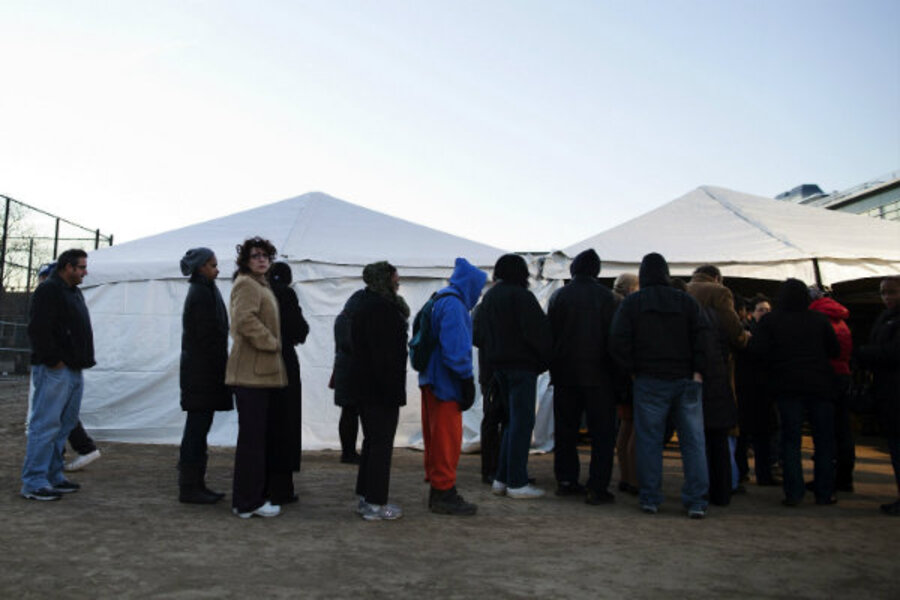Hurricane Sandy blows climate change back on the table
Loading...
| Somerville, Mass.
The devastation caused by superstorm Sandy, particularly in New York and New Jersey, is tragic, but the hurricane has at least put climate change back on the map. Scientists link climate change to increasingly volatile and extreme weather conditions, such as those experienced last week. Americans must take Sandy as a sign of what’s to come – based on a problem we have largely helped to create. Storms like Sandy are only part of a much larger issue that will wreak havoc far afield from the Eastern seaboard.
It’s unacceptable that it took a disaster like Sandy to finally bring climate change back into the conversation. Today is election day in the United States, but climate change should have been on the campaign agenda months ago. In fact, it should always be on the agenda. The evidence shouldn’t be disputed any longer. Climate change is real, and its effects are being seen in real time.
Climate change cannot be blamed for Sandy’s propagation, but it is linked to the magnitude and destruction we see with Sandy and similar storms. Warmer ocean temperatures fuel stronger cyclones, according to Radley Horton of The Earth Institute of Columbia University. Rising sea levels, like those New York has experienced over the last century, contribute to greater storm surge and flooding. What might have been a tame storm can become a monster – a Frankenstorm.
News of Sandy and its terror quickly circulated around the world, putting everyone’s eyes on the East Coast. However, it’s time the public looked toward the area most deeply endangered by and entangled in the issue of climate change. It’s time to look north.
As whispers of climate change first began to circulate, it was hypothesized that the greatest warming would occur in the Arctic. Data published earlier this year by NASA’s Goddard Institute for Space Studies clearly gives truth to this claim. Nine of the 10 warmest years in meteorological record have occurred since 2000, and the greatest increases in temperature have been experienced in the Arctic.
A heatwave in July 2012 melted 97 percent of the surface of Greenland's ice sheet. That’s the largest surface melting that has occurred in more than 30 years of satellite monitoring of the ice sheet. According to the National Snow and Ice Data Center, sea ice coverage in the Arctic this September narrowly avoided surpassing 2007’s all-time low. And most climate scientists predict the worst is yet to come.
Continued melting trends in the Arctic have the potential to fuel even higher temperatures. As snow and ice melt in the Arctic, the area loses albedo, or reflectivity. Less reflectivity means more heat is absorbed, leading to increased temperatures. Increased temperatures accelerate melting, which can cause glacial surges and increased calving of ice into the ocean. Melting also occurs within the land surface in areas of permafrost, or frozen ground. Some permafrost contains stores of greenhouse gases, which can be released into the atmosphere upon melting.
We are dealing with a large snowball of aggregated environmental issues, and we are coming dangerously close to pushing that snowball over the edge.
It’s hard to keep the effects of climate change in mind when much of what we experience in North America is isolated events or storms. But we have to keep climate change at the forefront; the Arctic is severely suffering from our consumerist and carbon belching lifestyle. And the issue isn’t just melting ice.
The international nonprofit WITNESS has partnered with other groups on its TRUST campaign, using video storytelling to highlight the effects of climate change in the lives of American youth. Nelson Kanuk, age 17, can only watch as melting permafrost in Alaska brings his home closer to the riverbank each year. Inuit are losing their ability to survive off of traditional subsistence hunting and are thus at risk for losing much of their identity and home. A multitude of species are experiencing range shifts and decreased numbers. Remember those adorable polar bears? Some have turned to cannibalism in order to skirt starvation.
In 2006, Time Magazine ran a special report on global warming with large, bold letters: “Be worried. Be very worried.” There is significant evidence of the insidious effects of climate change worldwide, and more obvious effects in the Arctic. If we ever want to see serious American climate change policy, we need to come to a greater consensus. Climate change is real, and it’s taking the land right out from under our feet.
Sarah Strand is an undergraduate student in the combined-degree program between the School of the Museum of Fine Arts and Tufts University, where she is majoring in geological sciences.





